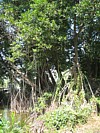Name of a group of tropical
halophytes, i.e.
trees, plants or shrubs
growing in coastal wetlands
near brackish and salt water areas of estuaries, including coastlines and shores.
There are many varieties of mangrove,
including the
Sonneratia and
Avicennia, the Rizophora species and the larger
Bruguiera trees.
Sonneratia and
Avicennia have a long cable root system underneath the ooze as well as prickle roots,
the so-called
pneumatophores,
growing above the
surface of the
shore-mud (fig.) and
used for taken
in oxygen through special pores
during low tide. These pneumatophores also
excrete excess salt making the shrub tolerant of high salinity. The
Sonneratia and
Avicennia differ in the colour of their leaves, with those of the
Sonneratia usually being lighter in colour.
Rizophora on the other
hand are characterized by their distinctive
long stilt-like
buttress roots
(fig.) that grow above ground
(fig.)
and which enable the sturdy tree to thrive in soft mud and prevent it from falling over
during strong tides. The
bruguiera trees grows in
rather compacted mud which is inundated with water only during high spring
tides. Mangrove has large round seed pods that grow separate from each other dangling from thin woody
wires. The unusual seed pods of the
bruguiera trees are equipped with dagger-shaped appendages
called viviparous propagules
(fig.) that enable them to penetrate the mud
when they drop, so they won't drift away with the tide. Due to this mangrove
forests often colonize large coastal areas, such as the Bay of
Phang Nga in Southern Thailand. Its
tangled root system
form a natural habitat for many animals,
such as
mudskippers
(fig.);
mangrove crabs (fig.),
including certain
fiddler crabs (fig.);
Yellow-ringed Cat Snakes;
Mangrove Pit Vipers (fig.);
Small-clawed
Otters and
Crab-eating Macaques, which in Thai are called
ling sahaem
(fig.), after the mangrove
they often live in. Mangrove wood
is burned to make charcoal (fig.).
The different varieties in Thai are:
lamphu (ลำพู)
and lamphaen (ลำแพน) for
species
in the group Sonneratia,
including the
Mangrove Apple
(fig.), prohng (โปรง) for
Ceriops,
sahaem (แสม)
for Avicennia,
gohng gahng
(โกงกาง)
or phang kah (พังกา) for Rizophora,
and
gohng gahng hua soom
(โกงกางหัวสุม)
for the Bruguiera, especially the Bruguiera
gymnorrhiza. The
gohng gahng or
Rizophora have several subspecies which are
commonly found in Thailand, including
gohng gahng bai lek (โกงกางใบเล็ก) or
‘small leaves
gohng gahng’ (Rizophora apiculata) and
gohng gahng bai yai (โกงกางใบใหญ่) or
‘large leaves gohng gahng’ (Rizophora
mucronata). The prohng or ceriops are also
dived into two main species, i.e. prohng daeng (โปรงแดง) or
‘red prohng’ (Ceriops tagal) and prohng khao or ‘white prohng’ (Ceriops
decandra). Often mangrove is
generally referred to as
ton gohng gahng (ต้นโกงกาง)
for the tree and pah gohng gahng (ป่าโกงกาง)
for the forest, regardless of the species, but also the term pah
chai len (ป่าชายเลน)
is frequently used, which literally means ‘wetland
forest’ and refers to a forest at the estuary of
a river, i.e. most likely mangrove. Besides this there are many
other species, some of them found worldwide, including black
mangrove (Avicennia germinans), white mangrove (Excoecaria agallocha)
and red mangrove (Rhizophora mangle). The latex or milky sap of
white mangrove is known for causing blisters on contact with the
skin and even temporary blindness if it contacts the eyes. Besides
its nickname milky mangrove, it is therefore also given the epithet
blind-your-eye mangrove, in Thai ton tah toom (ต้นตาตุ่ม), literally
‘sore eyes tree’ or ton tah toom taleh (ตาตุ่มทะเล),
‘sore eyes
coastal tree’.
回







